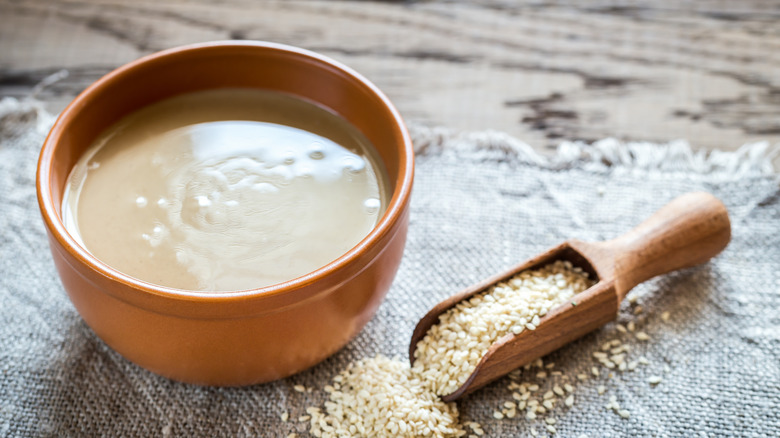Tzatziki Vs Tahini: What's The Difference Between The Sauces?
There are a lot of sauces and dips around the world; every culture has its own version because dipping one food into another is a universal joy of the human condition. And in Middle Eastern cuisine, two dips prevail above all others: tzatziki and tahini. If you're unfamiliar with either, you might think the relatively similar names mean they're relatively similar products.
This couldn't be further from the truth. It's impossible to confuse tzatziki and tahini; not only do they taste radically different in both flavor and texture, but they look radically different, too, because they're not even made from the same base: Tzatziki is a Greek sauce made from cucumbers and yogurt, while tahini is made from crushed sesame seeds. Surprisingly, despite the differences, you'll still sometimes use them in similar situations, like as a condiment in a wrap or pita — just when you want a different spin on the same basic dish. At other times, though, their purposes are radically different.
Tzatziki may be the world's most refreshing dip
There's nothing that cuts spice quite like tzatziki. The yogurt and cucumber qualities of the dip combine to form a taste as light as it is refreshing, and adding garlic, salt, herbs, lemon juice, and sometimes olive oil ensures nothing dull about the flavor. Yogurt's lower fat content also ensures it won't overwhelm a dish with richness. It's most often used as a dip on its own (especially with something like toasted pita) or as a condiment in things like gyros, souvlaki, or doner sandwiches and kebabs.
Interestingly, we don't know for sure where tzatziki comes from. It's most often associated with Greek cuisine (although it appears plenty in the Middle East). Still, it likely didn't originate there, as very similar dishes predate it from other countries. Cacik is a similar (albeit diluted version with water) dip that hails from the Ottoman Empire, and there's an even older yogurt-based dip from India called raita. Though it can't be determined with certainty, the strong theory from food historians is something like tzatziki, which started in India and made its way West, evolving as it went before reaching its final form in Greece.
Tahini is the basis for a lot of other dishes
Tahini can undoubtedly be used similarly to tzatziki (you'll see it as a condiment in pitas and wraps sometimes), but it also has uses beyond that. It's also more straightforward in terms of ingredients than tzatziki, made from crushed and ground sesame seeds mixed with olive oil to form a paste. While tzatziki is typically just itself in any dish, tahini is often used as the basis for many globally popular Middle Eastern dishes like hummus and baba ghanoush. While it doesn't quite have the refreshing quality of tzatziki, tahini tends to bring a nutty quality to dishes that give them a great depth of flavor.
Sesame seed was initially harvested in India around 5000 BCE, so tahini followed a similar route west to the Middle East — although, in this case, it seems like tahini paste probably spread outward from Persia, near present-day Iran. Wherever it came from, it's spread wildly throughout the region (unsurprising, considering its versatility), and versions can be found not just in the Levant but throughout the Balkans, Eastern Europe, and North Africa, and especially in the territory once controlled by the Ottoman Empire.
So even though tzatziki and tahini start with the same letter and come from similar areas, they're radically different. There's no denying they're equally delicious, albeit in different ways.


